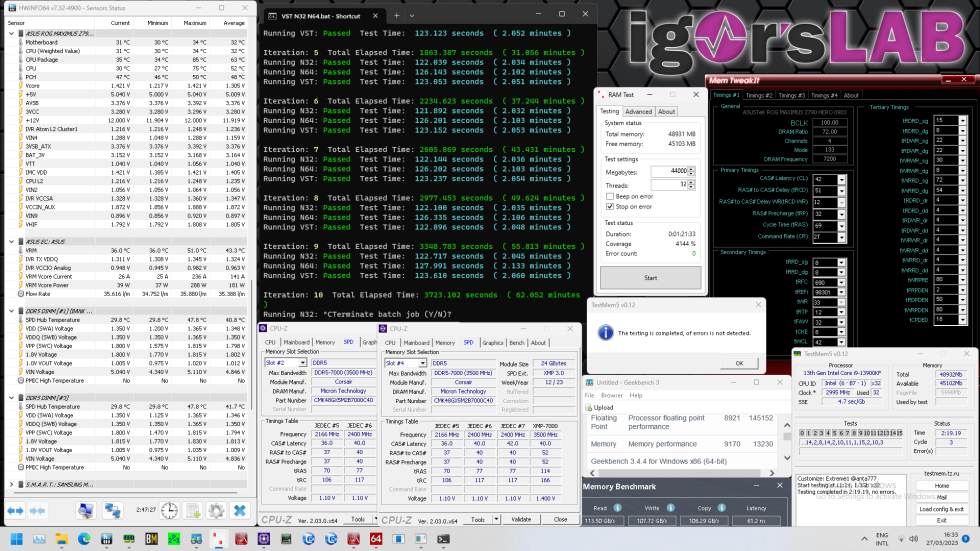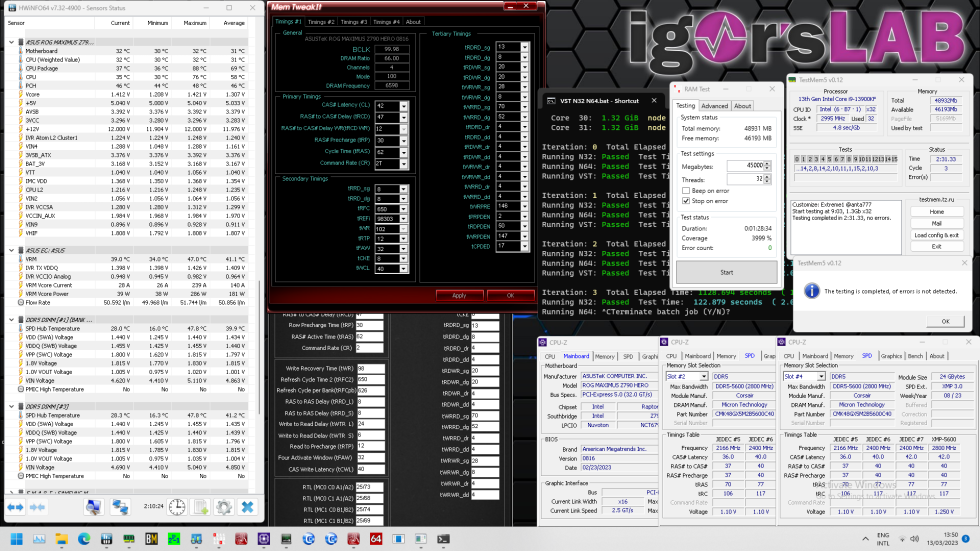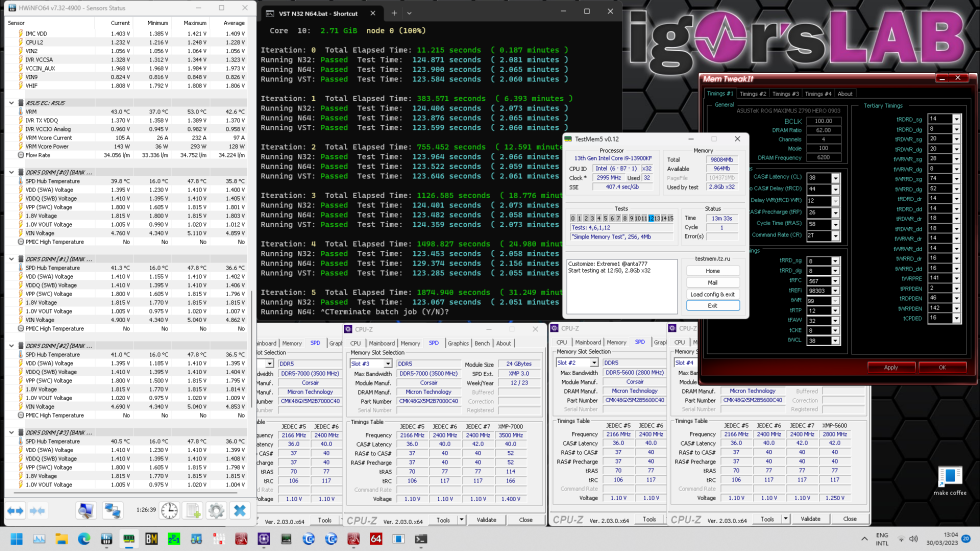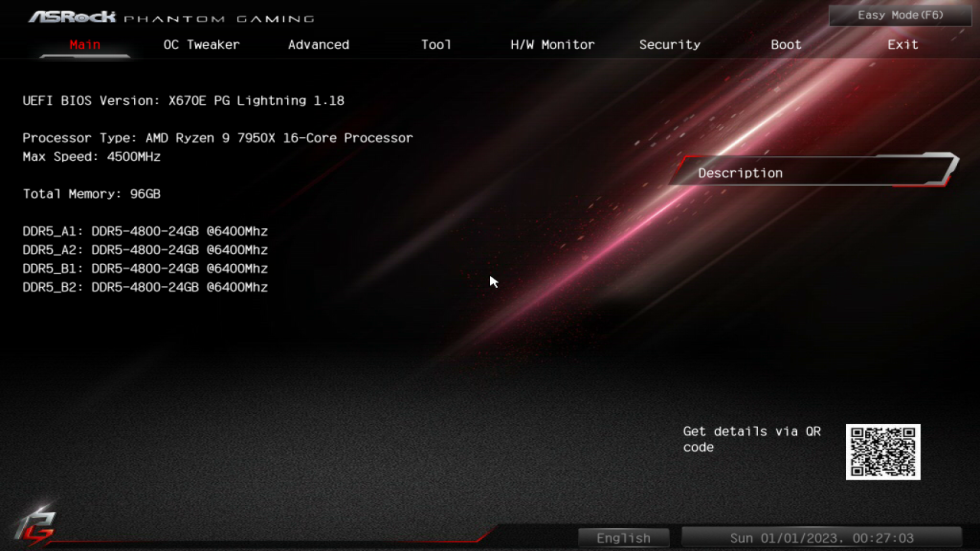Loading the XMP profiles is no problem with either kit on the Z790 Hero motherboard. It is only important that a relatively new BIOS is used. Only from BIOS version 0816 on, the 7000 SKU was then really completely stable with XMP settings. Speaking of XMP, the “XMP Tweaked” settings suggested by Asus should not be used with these RAM kits. The reason for this is the too tight tWRWR_sg timing of 16, which the Micron 24 Gbit RevB ICs simply cannot manage. Instead, you should stick with the standard XMP timings in XMP I or XMP II – these are not a problem.
DDR5-7200 with the 7000 SKU
The DDR5-7000 SKU is specified with its XMP profile at 1.4 V VDD and VDDQ. However, if you want to increase the clock rate a bit more and tighten the timings, less voltage was more, at least with my kit, so that 1.35 V seems to be the optimum. So a PMIC with more than 1.435 V limit would not be necessary here anyway.
The timings are generally much looser than for example 16 Gbit dies from Hynix or Samsung. tCL 42 and tRCD 51 are unfortunately quite disappointing at 7200 Mbps, but at least Micron-typically the tRP timing can be lowered significantly to 32 here. What Micron’s newest ICs still don’t like at all are write operations, most clearly seen in the tWRWR_sg timing of 30. For comparison, Hynix 16 Gbit A manages a value of 9, so it needs less than 1 third of the time for the same operation.
In the end, we still get a good 13000 points in Geekbench 3 multi-core memory performance, 106 – 114 GB/s bandwidth and a good 60 ns latency in AIDA. That is not groundbreaking, but at least a clear step forward for Micron compared to 16 Gbit RevA and RevG (I had already tested it privately). And on top of that, you get 50% more capacity – you shouldn’t forget that.
5600 kit with DDR5-6600
The DDR5-5600 kit can unfortunately be overclocked much less well than the top SKU, so that the end of stability is already reached here at 6600 Mbps. It is interesting that this kit prefers more voltage and could possibly even benefit from an “unlocked” PMIC. The timings are roughly analogous to the overclocking of the 7000 kit, with the exception of the tWR or tWRPRE settings. Recovering from write operations is so not in this kit’s nature, because an effective tWR of 98 is already not far from the JEDEC minimum.
It is striking how differently the kits behave with clock rate, timings and preferred voltage. A good bit of binning on the part of Corsair is probably at play here, because at least according to the part numbers from Spektek and Micron, the same grade and bin is installed in both kits.
Just under 100 GB DDR5 at 6200 Mbps
Out of interest and because the Z790 Hero board has 4 DIMM slots, I’ve added both kits in tandem, but this configuration won’t appear in the following benchmarks. I was only interested in how far you can clock a dual-rank topology of the new ICs distributed over 4 DIMMs. At least DDR5-6200 are still stable here, whereby the timings are dictated by the worse of the two kits. There are still just under 12000 points in the multi-core memory performance test, Geekbench 3, which, as is well known, utilizes several ranks relatively strongly, which is quite respectable for almost 100 GB of DDR5 RAM.
Attention Zen 4 users – even 2x 24 GB DDR5-3600 (currently still) unstable
And yes, I also tried the DIMMs with the new ICs on a current X670E board with Ryzen CPU. Already at the launch, reports circulated in the net that AMD systems could not yet handle Micron’s new 24 Gbit candidates and this is unfortunately confirmed in our case. Both kits can be booted in tandem with DDR5-6400, but not even 2 modules are stable with DDR5-3600, so that the system always bluescreens when loading Windows. The ICs must need some training routine, which AMD has not yet integrated into the AGESA.
I tested the newest BIOSes with AGESA 1.0.0.5c and 1.0.0.6 on the ASRock X670E PG Riptide and the Asus Crosshair X670E Gene and both behave equally unstable. Here remains only the hope that AMD considers the Micron 24 Gbit RevB ICs in their next AGESA release.



































12 Antworten
Kommentar
Lade neue Kommentare
Veteran
Urgestein
Veteran
Urgestein
Veteran
Veteran
Urgestein
Urgestein
Urgestein
Mitglied
Veteran
Neuling
Alle Kommentare lesen unter igor´sLAB Community →